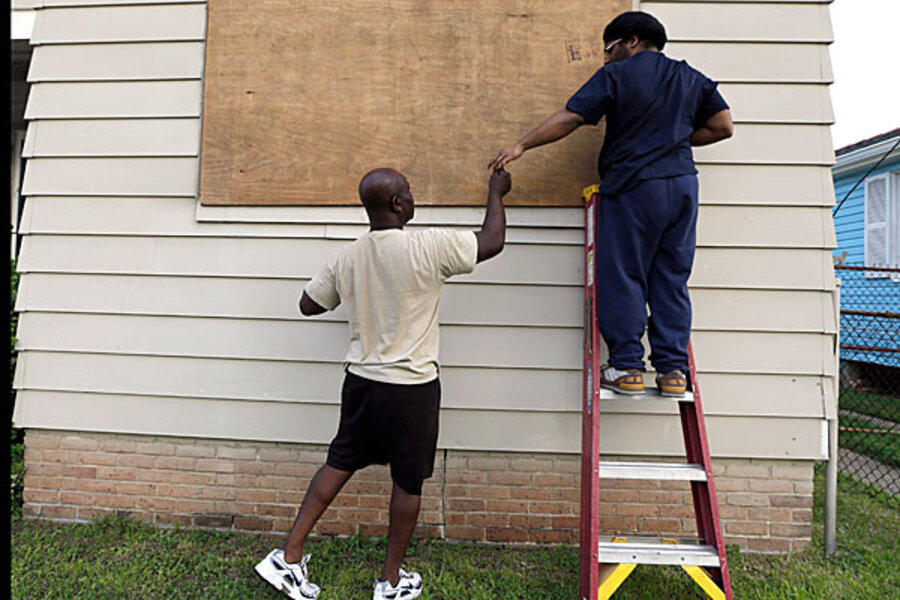As Isaac nears hurricane strength, New Orleans braces for flooding
Loading...
| Chauvin, La.
Isaac was on the verge of ballooning into a hurricane Tuesday that could flood the coasts of four states with storm surge and heavy rains on its way to New Orleans, where residents hunkered down behind levies fortified after Katrina struck seven years ago this week.
Shelters were open for those who chose to stay or missed the chance to get away before the outer bands of the large storm blow ashore ahead of a forecast landfall in southeast Louisiana on Tuesday night or early Wednesday.
The U.S. National Hurricane Center in Miami predicted Isaac would power up to hurricane strength, which starts at winds of 74 mph, later in the day and be at least a Category 1 hurricane by the time it's expected to reach the swampy coast of southeast Louisiana.
In Houma, a city southwest of New Orleans, people filled a municipal auditorium-turned-shelter. Simon and Crystal Naquin were there with their teenage sons because the camper they call home sits in a flood-prone spot between a navigation canal and lower Bayou Caillou.
RECOMMENDED: 5 ways to stay safe in a hurricane
Simon Naquin said he rode out hurricanes when he was younger, but doesn't do that anymore since seeing the damage wrought by hurricanes Andrew, Katrina and Rita.
"Now that I got kids, I've seen too much to say, 'Stay,'" said Naquin, who shared a twin air mattress with his wife while their sons read and snacked on jambalaya amid a pile of blankets and next to a stash of water bottles and food.
Forecasters warned that Isaac was a large storm whose effects could reach out 200 miles from its center. Water may be worse than wind because the storm could push walls of water while dumping rain to flood the low-lying coast in Louisiana, Mississippi, Alabama and the Florida Panhandle.
The U.S. National Hurricane Center in Miami predicted Isaac would power up to hurricane strength, which starts at winds of 74 mph, later in the day and be at least a Category 1 hurricane by the time it's expected to reach the swampy coast of southeast Louisiana.
Isaac's track is forecast to bring it to New Orleans seven years after Katrina hit as a much stronger storm on Aug. 29, 2005.
This time, federal officials say the updated levees around the city are equipped to handle storms stronger than Isaac. The Army Corps of Engineers was given about $14 billion to improve flood defenses, and most of the work has been completed.
New Orleans Mayor Mitch Landrieu did not activate a mandatory evacuation Monday. Instead, officials urged residents to hunker down and make do with the supplies they had.
But with landfall expected near the Katrina anniversary, anxiety was high, especially in the Lower 9th Ward, wiped out by Katrina after floodwalls burst and let the waters rush in.
"I don't really trust the levees," said Robert Washington, who planned to evacuate along with his wife and five children. "I don't want to take that chance. I saw how it looked after Katrina back here."
He leaned over the banister of his porch railing and looked out onto empty lots where houses stood before Katrina. His neighborhood, just a few blocks away from where the floodwall protecting the Lower 9th Ward broke open, remains largely empty.
A few streets over, Arthur Smith was unpacking supplies from his car and taking them into his renovated house.
"We have the lamp oil, the water, non-perishable food items, the radio that works without a battery," he said, listing some items on his checklist.
He was planning to either evacuate or hunker down with his 76-year-old mother and sister. He said that decision would be made Tuesday morning once Isaac's forecast became better defined.
Early Tuesday, Isaac was packing top sustained winds of 70 mph. The storm system was centered about 105 miles south-southeast of the mouth of the Mississippi River just before 8 a.m. EDT and moving northwest at 7 mph, according to the National Hurricane Center in Miami.
Although Isaac's approach on the eve of the Katrina anniversary invited comparisons, the storm is nowhere near as powerful as Katrina was when it struck. Katrina at one point reached Category 5 status with winds of more than 157 mph, and made landfall as a Category 3 storm.
Still, forecasters at the National Hurricane Center warned that Isaac, especially if it strikes at high tide, could cause storm surges of up to 12 feet along the coasts of southeast Louisiana and Mississippi and up to 6 feet as far away as the Florida Panhandle..
Rain from the storm could total up to 14 inches, with some isolated areas getting as much as 20 inches, along the coast from southeast Louisiana to the extreme western end of the Florida Panhandle.
RECOMMENDED: 5 ways to stay safe in a hurricane
___
Burdeau reported from New Orleans.
Copyright 2012 The Associated Press.







